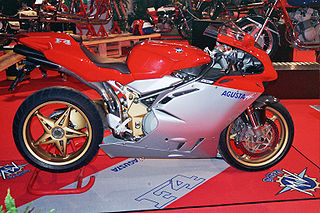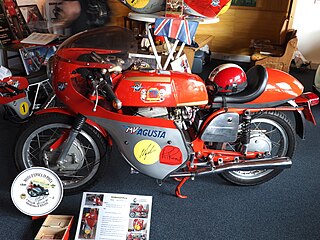Related Research Articles

MV Agusta is a high end motorcycle manufacturer founded by Count Domenico Agusta on 19 January 1945 as one of the branches of the Agusta aircraft company near Milan in Cascina Costa, Italy. The abbreviation MV stands for Meccanica (mechanics) Verghera, the hamlet where the first MVs were made. The modern headquarters and main production facilities are located in Varese, Italy on the shore of Lake Varese.

The MV Agusta F4 is an inline four-cylinder sport bike made by MV Agusta from 1999 until 2018. It was the motorcycle that launched the resurrection of the brand in 1998. The F4 was created by motorcycle designer Massimo Tamburini at CRC, following his work on the Ducati 916. The F4 has a single-sided swingarm, large diameter front forks and traditional MV Agusta red and silver livery. The F4 engine is also one of the few production superbikes to have a hemi-spherical cylinder head chamber design with 4 valves per cylinder.

The MV Agusta 350B (Bicilindrica) was a series of motorcycles produced by the Italian manufacturer MV Agusta from 1970 to 1974. The motorcycle was first introduced at the Milan motorcycle show in 1969. The introduction of the "350" model was intended to bridge the production gap of MV Agusta in the medium-displacement sector and to take advantage of the prestige gained by the dominant GP racers. It was produced in "Sport", "Gran Turismo" and "Scrambler" versions.

The MV Agusta 750 S also known as the MV Agusta 750 Sport, was a motorcycle manufactured by the MV Agusta company from 1970 to 1975. Production total of this model series was 583 machines.

The MV Agusta 600, also called the MV Agusta 600 4C and the MV Agusta 600 Turismo, was a motorcycle built by the MV Agusta company from 1966 to 1970. For the first time, a four-cylinder engine was fitted transversely to the direction of travel on a standard motorbike and cable-operated disc brakes were used. A total of 135 of this model were manufactured.

The MV Agusta 250 Monocilindrica Bialbero was a 250 cc factory racer manufactured by the Italian brand MV Agusta from 1956 to 1959. With this machine 15 GPs, 2 Driver Championships and 2 manufacturers World Championships were won.

The MV Agusta 250 Bicilindrica was a 250 cc factory racing motorcycle manufactured by the Italian brand MV Agusta from 1957 to 1961. With this machine 11 GPs, 2 Driver Championships and 2 manufacturers World Championships were won.

The MV Agusta 175 were a series of motorcycles produced by the Italian manufacturer MV Agusta from 1953 to 1960. The series included touring, GT, sports and supersports models. There were also two racing variants. Because of the shape of the petrol tank, the sports and supersport models became known as the Disco Volante. The series was MV's best seller.

The MV Agusta 125 Motore Lungo, more commonly known as the "carter lungo", was a 125 cc, lightweight two-stroke motorcycle manufactured between 1950 and 1953 by Italian motorcycle manufacturer MV Agusta. The machine was often used in racing.

The MV Agusta 125 Pullman was a motorcycle produced by the Italian manufacturer MV Agusta from 1953 to 1956. The model achieved a good sales success, and had the highest production of any machine from MV Agusta. Many brought the bike as the only means of family transport or as a work vehicle. Despite the questionable aesthetics, the Pullman offered a comfortable ride, derived by the driving position, soft suspension and large section tires. This was particularly appreciated by users, so much so that they were imitated by some competitors. 27,000 machines of this model series were produced. The model was also produced under licence in Spain by Avello, where it was marketed as the MV Avello 125 Pullman Turismo.

The MV Agusta Turismo Veloce is a motorcycle produced by the Italian motorcycle manufacturer MV Agusta. The machine premiered at the 2013 EICMA, but production was delayed due to the financial crisis being experienced by the manufacturer. The motorcycle was first made available to the press for road tests in April 2015.

The MV Agusta Superveloce is a retro racer styled motorcycle produced by the Italian motorcycle manufacturer MV Agusta in 2020. It is described by MV Agusta as "a modern interpretation of the iconic stylistic concept of the MV Agusta. A fusion of vintage and contemporary ensures that the future incorporates the memories of good times gone by".

The MV Agusta 350 Ipotesi (Hypothesis) was a motorcycle produced by the Italian manufacturer MV Agusta from 1975 to 1977. The machine was conceived by Italian designer Giorgetto Giugiaro and based on the previous 350 B Sport Elettronica model. 1,991 "Sports" and 350 “Turismo” machines were produced.

The MV Agusta 125 Regolarità was a dual-sport motorcycle built from 1965 to 1970 by the Italian manufacturer MV Agusta at their Cascina Costa plant. Production was 63 machines, built in 2 batches; 46 in 1965 and 17 in 1969.

The MV Agusta 125 Sport SE was a sport motorcycle built from 1975 to 1977 by the Italian manufacturer MV Agusta. It was one of the last models to be produced by Meccanica Verghera at their Cascina Costa plant.

The MV Agusta 150 Sport RS was a motorcycle produced by the Italian motorcycle MV Agusta in their Cascina Costa plant from 1959 to 1969.

The MV Agusta Raid was a series of 250 and 300 cc motorcycles manufactured by the MV Agusta company in Cascina Costa, Italy from 1957 to 1961. At the time of introduction, the 250 cc class was considered a large capacity motorcycle.

The Ducati 350 Scrambler, also known in the US as the Ducati 350 SS and in Europe as the Ducati 350 SCR is an on/off-road 340 cc (21 cu in) single cylinder bevel drive SOHC motorcycle produced by the Italian manufacturer Ducati from 1968 to 1974. It was the first of the 'wide case' Ducati singles produced and aimed at the American Market. Total production was around 11,500 machines.

The Ducati Deluxe is a 247 cc (15.1 cu in) single cylinder bevel drive SOHC motorcycle produced by the Spanish manufacturer MotoTrans, who were licensed by Ducati to produce motorcycles under the Ducati brand name. The model was based on the 'narrow case' Ducati Diana 250 and produced from 1963 to 1973. The Deluxe was, in terms of production numbers, MotoTrans' most successful model.

The Ducati Road 250 is a 247 cc (15.1 cu in) single cylinder bevel drive SOHC motorcycle produced by the Spanish manufacturer MotoTrans, who were licensed by Ducati to produce motorcycles under the Ducati brand name and was produced from 1972 to 1977. The model was intended to be a Spanish domestic market version of the 250 Scrambler, although it was also exported to the US in 1972/3.
References
- 1 2 3 "MV Agusta 250 Bicilindrica". www.mv-agusta-club.de (in German). MV Agusta Club Deutschland. Retrieved 3 October 2019.
- ↑ "MV Agusta 250 Bicilindrica Scrambler". www.mv-agusta-club.de (in German). MV Agusta Club Deutschland. Retrieved 3 October 2019.
- 1 2 3 4 5 6 7 "250 Bicilindrico "B"" (PDF). www.glaagusta.org. Retrieved 2 October 2019.
- 1 2 3 "250 Bicilindrico B "Scrambler"" (PDF). www.glaagusta.org. Retrieved 3 October 2019.
- ↑ "Classic MV Agusta -". thebikemuseum.com. The Bike Museum. Retrieved 3 October 2019.
- 1 2 3 4 5 6 7 8 Pasi, Aberto (16 December 2018). "MV Agusta 166 Arno GT: cilindrata letale". www.motociclismo.it (in Italian). Retrieved 2 October 2019.
- 1 2 3 "c.1969 MV Agusta 250B Frame no. MV250B*2110381* Engine no. *2110365*". www.bonhams.com. Bonhams. Retrieved 2 October 2019.
- 1 2 3 4 Brown, Roland; Pons, M. Àngels (3 February 2010). "MV Agusta 350 GT (1972)". Motofan (in Spanish). Retrieved 2 October 2019.
- ↑ "600 Turismo "4C 6"" (PDF). www.glaagusta.org.
- ↑ "350 B "Sport"" (PDF). www.glaagusta.org. Retrieved 2 October 2019.
- ↑ "MV Agusta Arno 166 GT". www.mv-agusta-club.de (in German). MV Agusta Club Deutschland. Retrieved 3 October 2019.